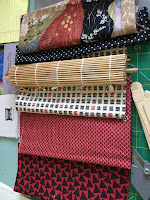This was a very unsatisfying tiny construction project. I cavalierly
slogged on a wet coat of red ink, using it like stain, over all the
pieces planned for this little red structure.
This was my first mistake, since the wet ink warped all the jumbo craft sticks, aka, my tiny lumber. Also, I made the tray for it to sit upon out of basswood, which absorbed the stain differently and dried much more red than the craft sticks, so I threw on some chalk paint to give the tray an antique look.
That was OK, but, I designed the structure much like the first tea room (modeled on the YouTube tutorial that taught me everything I know so far about constructing Japanese Tea Houses) with single walls supported by little square posts, which was not enough to make up for the fact that all the boards were warped. Time to advance to more grown up materials - in this case, basswood and balsa.
There is no roof for this structure, because in the middle if its difficult and wobbly construction, I realized it looked more like a bat and board barn from the 60s rather than a Japanese Tea House. Suddenly, the black dragons I imagined painted on the exterior walls didn't make sense any more.
I also learned the hard way that if you are planning to install interior wall coverings, you'd better do it before gluing the box together.
So, in the next post, we'll explore tiny double wall construction. Also a step up.
This was my first mistake, since the wet ink warped all the jumbo craft sticks, aka, my tiny lumber. Also, I made the tray for it to sit upon out of basswood, which absorbed the stain differently and dried much more red than the craft sticks, so I threw on some chalk paint to give the tray an antique look.
That was OK, but, I designed the structure much like the first tea room (modeled on the YouTube tutorial that taught me everything I know so far about constructing Japanese Tea Houses) with single walls supported by little square posts, which was not enough to make up for the fact that all the boards were warped. Time to advance to more grown up materials - in this case, basswood and balsa.
There is no roof for this structure, because in the middle if its difficult and wobbly construction, I realized it looked more like a bat and board barn from the 60s rather than a Japanese Tea House. Suddenly, the black dragons I imagined painted on the exterior walls didn't make sense any more.
I also learned the hard way that if you are planning to install interior wall coverings, you'd better do it before gluing the box together.
So, in the next post, we'll explore tiny double wall construction. Also a step up.










































